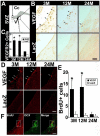Attenuation of brain response to vascular endothelial growth factor-mediated angiogenesis and neurogenesis in aged mice
- PMID: 19745179
- PMCID: PMC2783321
- DOI: 10.1161/STROKEAHA.109.561050
Attenuation of brain response to vascular endothelial growth factor-mediated angiogenesis and neurogenesis in aged mice
Erratum in
-
Correction.Stroke. 2015 Jun;46(6):e158. doi: 10.1161/STR.0000000000000068. Stroke. 2015. PMID: 26002983 No abstract available.
Abstract
Background and purpose: Alterations of neuroangiogenic response play important roles in the development of aging-related neurodisorders and affect gene-based therapies. We tested brain response to vascular endothelial growth factor (VEGF) in aged mice.
Methods: Adeno-associated viral vector (AAV)-VEGF, an adeno-associated viral vector expressing VEGF, was injected into the brain of 3-, 12-, and 24-month-old mice. AAV-LacZ-injected mice were used as controls (n=6). Before euthanasia at 6 weeks after vector injection, the mice were intraperitoneally injected with 5-bromodeoxyuridine for 3 consecutive days. The vascular density and the number of neuroprogenitors were analyzed.
Results: Injection of AAV-VEGF increased the vascular density in the brain of 3-, 12-, and 24-month-old mice by 22%+/-7% (AAV-VEGF: 320+/-15 per 10x field versus AAV-LacZ: 263+/-8, P<0.05), 20%+/-8 (AAV-VEGF: 300+/-9 versus AAV-LacZ: 250+/-11, P<0.05), and 7%+/-16% (AAV-VEGF: 257+/-27 versus AAV-LacZ: 236+/-13, P=0.283), respectively. There were more VEGF receptor-positive neuroprogenitors in the subventricular zone of AAV-VEGF-injected 3- (22+/-2) and 12-month-old mice (21+/-5) than that of 24-month-old mice (7+/-1). More 5-bromodeoxyuridine-positive endothelial cells and neuroprogenitors were detected around the injection site and subventricular zone of 3- (13+/-4) and 12-month-old mice (14+/-5) than that of 24-month-old mice (1+/-1). VEGF receptor 2 was upregulated in AAV-VEGF-injected brains of 3- and 12-month-old mice, but not in 24-month-old mice.
Conclusions: The angiogenic and neurogenic response to VEGF stimulation is attenuated in the aged mouse brain, which may be due to reduced VEGF receptor activity.
Figures





References
-
- Greenberg DA, Jin K. From angiogenesis to neuropathology. Nature. 2005;438:954–959. - PubMed
-
- Olsson AK, Dimberg A, Kreuger J, Claesson-Welsh L. VEGF receptor signalling - in control of vascular function. Nat Rev Mol Cell Biol. 2006;7:359–371. - PubMed
-
- Zachary I, Gliki G. Signaling transduction mechanisms mediating biological actions of the vascular endothelial growth factor family. Cardiovasc Res. 2001;49:568–581. - PubMed
-
- Krupinski J, Kaluza J, Kumar P, Kumar S, Wang JM. Role of angiogenesis in patients with cerebral ischemic stroke. Stroke. 1994;25:1794–1798. - PubMed
-
- Yancopoulos GD, Davis S, Gale NW, Rudge JS, Wiegand SJ, Holash J. Vascular-specific growth factors and blood vessel formation. Nature. 2000;407:242–248. - PubMed
Publication types
MeSH terms
Substances
Grants and funding
LinkOut - more resources
Full Text Sources
Other Literature Sources
Medical

